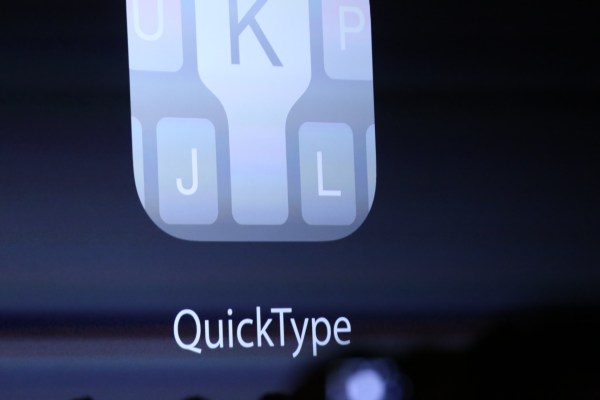Apple is finally giving a little serious love to the overlooked iOS keyboard.
The forthcoming iOS 8 update, which it detailed on stage this morning at its WWDC 2014 event, will include a next-word prediction feature called QuickType. And — in even bigger news — iOS 8 will get system wide support for third party keyboards, which means alternative keyboard apps like Swype et al will be able to bring their apps to the iPhone and iPad.
QuickType
First up, Apple introduced a native machine learning technology called QuickType that it said will adapt to the iOS user’s use of language over time to offer customised next word predictions as they type.
Three next word predictions are positioned just above the iOS keyboard so the user can tap once to select a correct next-word predictions, rather than having to tap out all the rest of the letters in the word.
Suggestions are even customised per app. “It learns how you type in different apps,” noted Apple’s Craig Federighi.
Suggestions also differ based on the particular person you are speaking to, and the language you use with them. And can also pre-respond to an either/or question like ‘dinner or a movie’ — by suggesting ‘dinner’, ‘movie’ or ‘not sure’.
The next-word predictions are done locally on the device, according to Federighi.
[gallery ids="1010710,1010709,1010715"]
Next-word suggestions is something that’s been a staple offering on Android devices for years, via third party keyboard apps like SwiftKey. Even BlackBerry’s latest OS, BlackBerry 10, includes next word predicting software built-in so Apple is definitely playing catch up there.
Still, it’s a much needed addition that should help speed up typing on iOS devices a tad. It’s unclear whether Apple is licensing the machine learning technology that powers QuickType from a third party, or whether it has built the system itself.
Third party keyboards are a-coming
Next, Apple pulled an even bigger keyboard surprise out of its hat which gives users the ability to radically overhaul their iOS typing experience if they wish by announcing support for installing third party system wide keyboards is being added to iOS 8.
This is HUGE.
It means iOS users will be able to change the input mechanism on the native keyboard — to, for instance, add a Swype-style input method if they so choose, rather than being stuck with Apple’s standard, typewriter-inspired Qwerty.
Indeed, Apple demoed this on stage using Swype as an example.
In a statement emailed to TechCrunch SwiftKey’s co-founders also confirmed they will bring their keyboard to iOS. “Are we going to build SwiftKey Keyboard for iOS8? Of course we are. We’ve already started,” they said, pointing out that they have been waiting/hoping for this moment for more than four years.
“We’re delighted Apple has decided to embrace the importance of opening its platform to third party keyboards… Our technology features on more than 200 million devices to date and we can’t wait to reach more,” they added.
Frankly this is what iOS-owning keyboard nerds have also been crying out for for years. And years. The iOS keyboard has been in effective stasis since the launch of the original iPhone way back in 2007. It’s also been sandboxed from all the exciting developments going on in the Android ecosystem. Not any more. So, in short, hallelujah!
The change opens the floodgates to keyboard software developers who have been beavering away on Android to port their wares to iOS. Beyond the big names like Swype and SwiftKey with huge existing user bases on Android, smaller devs with new ideas will no longer be entirely locked out of Apple’s walled garden. And iOS will no longer be a barren wilderness for keyboard innovation. Whether it’s squashed Qwertys or invisible Qwertys. Or something else entirely. Whatever it is, iOS will be able to partake.
One more thing: all of these keyboard updates are great news for iOS users, but probably not such great news for cult typo site Damn You Autocorrect!
iOS 8 is due to arrive for users this fall. Expect keyboard disruption to follow — at long last.
